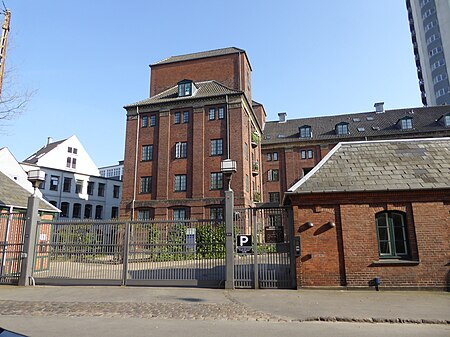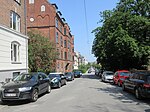Rahbeks Allé Brewery
Brewery buildings in CopenhagenDanish companies established in 1860Defunct breweries of DenmarkDefunct food and drink companies of DenmarkIndustrial buildings completed in 1861 ... and 1 more
Industrial buildings in Vesterbro/Kongens Enghave

Rahbeks Allé Brewery (Danish:Bryggeriet i Rahbeks Allé) is a former brewery at Rahbeks Allé 3–11 in Copenhagen, Denmark. The brewery was founded in 1860 and merged with several other breweries under the name De Forenede Bryggerier in 1890. It was from 1923 operated under the name Kongens Bryghus and the site was decommissioned when De Forenede Bryggerier was acquired by Carlsberg Group in 1969. The buildings—a group of red brick buildings from 1860-61 by Jens Eckersberg and a tall, round silo from 1857 designed by Tyge Hvass—have now been converted into apartments.
Excerpt from the Wikipedia article Rahbeks Allé Brewery (License: CC BY-SA 3.0, Authors, Images).Rahbeks Allé Brewery
Rahbeks Allé, Copenhagen
Geographical coordinates (GPS) Address Nearby Places Show on map
Geographical coordinates (GPS)
| Latitude | Longitude |
|---|---|
| N 55.669638888889 ° | E 12.537047222222 ° |
Address
Rahbeks Allé 7
1749 Copenhagen
Capital Region of Denmark, Denmark
Open on Google Maps










